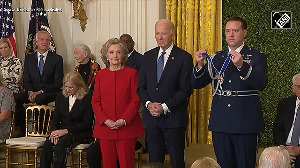The centre’s promise of a new deal for the states is a welcome development, whatever may be its shortcomings, explains A K Bhattacharya.
 States are in the news these days. Everybody seems to be worried about how the states should get a better deal from the Centre.
States are in the news these days. Everybody seems to be worried about how the states should get a better deal from the Centre.
In recent weeks, many announcements have been made to show how the government’s new initiatives will result in significant financial gains for the states.
Going by such claims, it would appear that it is now time to celebrate a new phase of a fair and equitable fiscal relationship between the Centre and the states.
Surprisingly, however, not all states seem to be happy. It is, therefore, reasonable to take a close look at these initiatives and assess how real those promised financial gains are and whether they actually represent a new challenge for governance.
One of the most recent and well-publicised pushes towards ensuring for the states a higher share of central revenues came from the 14th Finance Commission.
It recommended that the states’ share in the divisible pool of central revenues should be 42 per cent, up by about 10 percentage points.
The National Democratic Alliance government of Narendra Modi accepted it and Finance Minister Arun Jaitley announced with an unconcealed sense of pride that the government had agreed to accept that “unprecedented increase” in devolution, which would “empower states with more resources”.
That was what the finance minister said in his Budget speech delivered in February.
Accordingly, the net resources the Centre will transfer to the states and Union Territories during 2015-16 are expected to rise to Rs 8.43 lakh crore, over 23 per cent more than were transferred in 2014-15.
That should have thrilled the states. But many of them appeared to be a little disappointed and began complaining.
The reasons for this reaction were not clear. What, however, became clear was that even as the government increased the tax devolution to states, it also implemented a new formula for funding major programmes under central assistance for state plans.
What does the new formula do? The Union government has decided to stop funding as many as 12 programmes. For another 13 programmes, the Union government’s funding will be reduced.
This will leave 23 programmes that will continue to be funded fully by the Centre. The finance ministry’s argument is that the new funding pattern has to be put in place because of the resources that would have otherwise been allocated for 25 schemes have already been subsumed in the award for resources transfer to states made by the 14th Finance Commission.
States will still be left with more resources, and will now enjoy a certain freedom to spend them according to their requirements. But questions of capacity and the ability to frame suitable programmes, resisting populist pressures, and implement them successfully will also have to be addressed.
Some states may have also been disturbed after realising that a higher share in the divisible pool of central taxes has already encouraged the Union government to make some clever tax changes in a manner that the incremental revenue does not become part of the divisible pool.
In other words, the states do not get any share in the revenues collected as a result of those changes.
Thus, wealth tax, whose collections though small were part of the divisible pool, was abolished and instead a surcharge was levied on the tax to be paid by those earning an annual income of over Rs 1 crore. The surcharge, thus, collected will not be shared with the states. Similarly, the excise duty increases on diesel and petrol, introduced during 2014-15, were replaced by cesses, which again were not part of the divisible pool of taxes.
Another occasion where the Centre talked about its promise of sharing financial resources with the states was the auction of coal blocks, whose allotment in the past several years had been declared illegal and cancelled by the Supreme Court.
As many as 33 coal mine blocks have been auctioned in two phases, fetching an estimated Rs 2 lakh crore by way of revenues from auction bid money and royalty. The Centre will not benefit from this exercise financially.
The entire auction and royalty proceeds will go to the states, where the auctioned mining blocks are located. The states of Odisha, Chhattisgarh, Jharkhand, Maharashtra and West Bengal will benefit from the auctions that have been concluded so far.
Shouldn’t the states be happy? Well, if you look at these figures a little more closely, you will realise the big bonanza that the Centre is talking about is a gain that would accrue to them only over the next 30 years or the life of the mining blocks.
Break that figure down to arrive at the annual gain for the various states, where the mines are located, and the actual gain does not look too big. Yes, of course, it is true that something is always better than nothing.
But the revenues from royalty will start coming in only when coal is produced and sold. So a substantial chunk of those revenues would go to the states only when production of coal begins, which may take some time.
The Centre’s promise of a new deal for the states is a welcome development, whatever may be its shortcomings.
In a quasi-federal country like India, it is important that the states enjoy a healthy relationship with the Centre and the country’s financial resources are equitably shared by all states.
The problem in delivering that promise arises when there is no forum at the Centre where the states and the Centre can meet and discuss how the resources could be shared and spent. Earlier the Planning Commission used to play that role.
The National Institution for Transforming India (NITI) Aayog seems to have a structure where there are committees and sub-committees that would have representation from the states to discuss various issues concerning them and the Centre.
But there is no clarity yet on whether such forums of the NITI Aayog can discuss financial allocations for the states. There is a need for a clear delineation of that role and whether the NITI Aayog should play it.









 © 2025 Rediff.com -
© 2025 Rediff.com -